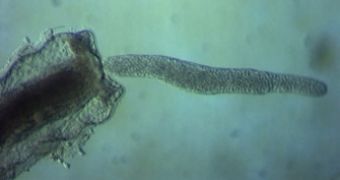A worm was believed to be a relatively evolved organism, with at least a defined gut and nervous system. But a new finding could redefine the notion of a worm. A new detailed DNA analysis has revealed that Buddenbrockia plumatellae, which looks and behaves like a worm, is actually related to jellyfish, sea anemones and hydras. This also challenges conventional knowledge about the evolution of animal body plans.
But cnidarians (jellyfish and their relatives) lack a clearly defined gut and nervous system. Buddenbrockia is one of the 2,000 microscopic species of myxozoans, animals that live like parasites inside aquatic animals. Their classification has always been a puzzle. Some DNA data pointed them to be rather higher animals, while other DNA data and also the presence of modified stinger cells, pointed to cnidarians. Unlike other more static myxozoans, Buddenbrockia has a worm-like shape and it wiggles restlessly, using four bands of muscles running through its body. This anatomy made many believe it was a more evolved animal.
But a team led by Peter Holland, an evolutionary developmental biologist at the University of Oxford compared 50 of Buddenbrockia's genes with the similar genes from 60 other species, from sponges to insects, crustaceans, cnidarians and vertebrates. This time the researchers used more DNA and more complex computer programs than previous investigations. Buddenbrockia turned out to undoubtedly be a weird cnidarian.
Scientists suppose that an elongated body shape evolved once, in the common ancestor of higher animals and cnidaria, but cnidarians lost this pattern. But the pattern re-evolved independently in Buddenbrockia.
Scientists have also long believed that crawling required bilateral symmetry (similar right and left sides) as seen from earthworms to snakes. But Buddenbrockia does not have the typical bilateral symmetry, thus this type of symmetry is not a prerequisite in the evolution of a mobile lifestyle.
"Weird animals can help us work out what is possible in evolution and what is not," said Holland.
"It is especially significant that the [wormlike] body plans were achieved independently in the cnidaria and in the higher animals. The cnidarians show us that a crawling habit need not be associated with bilateral symmetry. The work nails down the cnidarian connection," said John Finnerty, an evolutionary developmental biologist from Boston University in Massachusetts.
He would have liked to see more cnidarians in the analysis to locate the place of Buddenbrockia amongst them.

 14 DAY TRIAL //
14 DAY TRIAL //